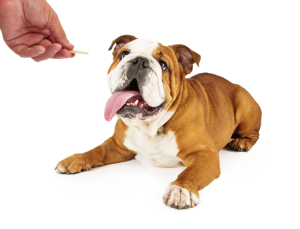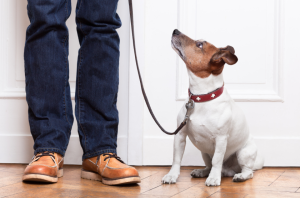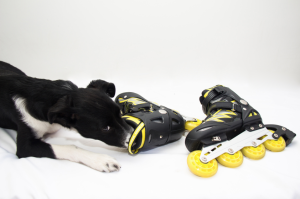 Most of us have heard of classical conditioning. Pavlov demonstrated how a neutral stimulus could become meaningful to a dog when followed by something that elicits a natural response. So when a bell, meaningless in itself, is consistently followed with food, the sound of the bell alone triggers salivation. This discovery had a major influence on how we understood learning and was a key element of Behaviorism, the most influential school of thought in the early 20th century. Even though today our understanding of behavior has broadened to also include cognitive, genetic and biological influences, classical conditioning still plays a major part in our dog’s behavior. And it’s not limited to training! All through the day, no matter how old, our dogs develop new associations that will influence how they feel, react and interact with the world around them. As their guardians and the source of most of their most basic needs, we play a fundamental role in what our pooch learns and how he feels about the world he lives in. A good understanding of classical conditioning can make a significant difference in influencing Fido’s behavior.
Most of us have heard of classical conditioning. Pavlov demonstrated how a neutral stimulus could become meaningful to a dog when followed by something that elicits a natural response. So when a bell, meaningless in itself, is consistently followed with food, the sound of the bell alone triggers salivation. This discovery had a major influence on how we understood learning and was a key element of Behaviorism, the most influential school of thought in the early 20th century. Even though today our understanding of behavior has broadened to also include cognitive, genetic and biological influences, classical conditioning still plays a major part in our dog’s behavior. And it’s not limited to training! All through the day, no matter how old, our dogs develop new associations that will influence how they feel, react and interact with the world around them. As their guardians and the source of most of their most basic needs, we play a fundamental role in what our pooch learns and how he feels about the world he lives in. A good understanding of classical conditioning can make a significant difference in influencing Fido’s behavior.
As Bob Bailey often says, Pavlov is always sitting on our shoulder. In other words, in every interaction between our dog and us or between our dog and the environment lies the potential to develop an association, positive, negative or neutral with the event. Since there is no need to learn to like food, dislike an electric shock or run away from a loud noise, this category of stimuli is said to be unconditioned. In other words, they didn’t require any prior learning to elicit a reaction. The principal behind classical conditioning is very straightforward. Anything neutral, like a sound, a place, a word or an event, followed with something naturally meaningful to the dogs (unconditioned), like food, an electric shock or a loud sound can become associated with either positive or negative things happening.
 In training we routinely use the dog’s ability to learn through this type of association. A clicker for instance is meaningless to the dog, until it’s consistently followed by food. In the same way, when we ask our dog to sit and give her a treat for putting her butt on the ground, just like the sound of the bell, after a few repetitions, the word ‘sit’ has become associated with food. Of course classical conditioning is not the only association happening and operant conditioning is also taking place: as is the case in most situations. We’ll cover the principals behind operant conditioning in a subsequent blog. What’s important here is to understand that part of the reason our dog is willing and happy to sit, is because the word ‘sit’, along with the action itself, are now associated with food. In the same way, when we treat the dog for walking nicely by our side when on leash, we’re also establishing a positive association in the dog’s mind with walking close by. If instead of using treats, we decided to resort to choke chains or prong collars, the dog would still learn the behavior, but as a side effect, would also develop unpleasant feelings with walking by our side through classical conditioning. This is where we can easily understand how our choice of training method has a big impact on our relationship with our dog.
In training we routinely use the dog’s ability to learn through this type of association. A clicker for instance is meaningless to the dog, until it’s consistently followed by food. In the same way, when we ask our dog to sit and give her a treat for putting her butt on the ground, just like the sound of the bell, after a few repetitions, the word ‘sit’ has become associated with food. Of course classical conditioning is not the only association happening and operant conditioning is also taking place: as is the case in most situations. We’ll cover the principals behind operant conditioning in a subsequent blog. What’s important here is to understand that part of the reason our dog is willing and happy to sit, is because the word ‘sit’, along with the action itself, are now associated with food. In the same way, when we treat the dog for walking nicely by our side when on leash, we’re also establishing a positive association in the dog’s mind with walking close by. If instead of using treats, we decided to resort to choke chains or prong collars, the dog would still learn the behavior, but as a side effect, would also develop unpleasant feelings with walking by our side through classical conditioning. This is where we can easily understand how our choice of training method has a big impact on our relationship with our dog.
How about when we’re not training? How does classical conditioning impact my dog’s behavior? Let’s take a few examples in humans first. If you wear glasses, you’ve probably been asked to sit in front of a device that blows a puff of air in your eye. It’s quite unpleasant and generally triggers a blinking reflex. Let’s imagine now that the doctor says the word ‘blue’ right before the air puff. The word blue generally doesn’t elicit any kind of emotional response, so we shouldn’t react to the word alone. How many repetitions would it take for you to start blinking to the word ‘blue’ alone? Let’s imagine now that you heard the word blue right before being hit in a car accident? Sometimes, when the intensity of the event is very strong, especially when fear is involved, it only takes once to have a lasting effect on us. That’s how many phobias start. In a famous experiment, Watson presented a white rat to a young 9 months old boy, little Albert. The boy wasn’t afraid of rats so he didn’t have any particular reaction in its presence and even played with it. During the experiment however, any time the baby reached out to touch the rat, loud steel clanging noises were made right behind the child. After only a few trials, when they brought the rat back in the room, even without the noises, little Albert was in a panic. The white rat, originally neutral, was now a conditioned stimulus (learned through association with the sound). Albert’s fear reaction later generalized to other white and fluffy things, like a white rabbit or a Santa Claus beard.
Let’s look at some common examples in dogs:
- You open a bag of chips and give one to the dog. It won’t be long before the dog runs to you when hearing the rip of the bag (this would also apply to the refrigerator door).
- When taking the dog to a vet clinic, initially neutral, the dog is handled, carried and poked by strangers. The sight of a vet clinic quickly becomes a source of stress for many dogs.
- When we bend over our dog, we generally pet our dog, but this one time we were in a hurry and firmly grabbed our dog’s collar and forcefully pushed our dog in his crate. What may have initially been associated with pleasant feelings, now elicits fear reactions in the dog who is now clearly showing signs of avoidance.
- We notice that our favorite pair of shoes has been shredded so we call the dog to express our anger. The dog has now associated us with the outburst and may display signs of fear in similar situations.
- When on a walk, anytime we notice another dog, we brace ourselves and tighten the leash, anticipating our dog to pull harder towards the other dog. With repetition, our pooch learns that the presence of other dogs, when on leash, is source of discomfort and may develop reactivity.
 We can go on and on with examples of how this type of associative learning affects our dog in all situations and throughout his life. What’s important to remember is that classical conditioning is almost always at play. What type of experience however, neutral, pleasant or unpleasant is highly dependent on the choices we make and on the temperament of the dog. Some dogs are naturally more confident and friendly than others. We can, for instance, avoid potential fears and anxieties by preventatively pairing food or other pleasant stimulus with certain events that are likely to be otherwise unpleasant, such as a vet visit (see related blog), nail trimming, grooming, crating, grabbing of the collar, strangers, other dogs, etc… It’s much easier to prevent the occurrence of fears from the beginning rather than having to treat them once there. Nonetheless, classical conditioning is also a great way to help an animal get over certain fears once acquired by pairing food for instance with the situation (while making sure we keep the dog under threshold for best results, in other words, at a level of exposure of the scary situation where the dog isn’t yet showing over signs of an emotional reaction)(see related blog).
We can go on and on with examples of how this type of associative learning affects our dog in all situations and throughout his life. What’s important to remember is that classical conditioning is almost always at play. What type of experience however, neutral, pleasant or unpleasant is highly dependent on the choices we make and on the temperament of the dog. Some dogs are naturally more confident and friendly than others. We can, for instance, avoid potential fears and anxieties by preventatively pairing food or other pleasant stimulus with certain events that are likely to be otherwise unpleasant, such as a vet visit (see related blog), nail trimming, grooming, crating, grabbing of the collar, strangers, other dogs, etc… It’s much easier to prevent the occurrence of fears from the beginning rather than having to treat them once there. Nonetheless, classical conditioning is also a great way to help an animal get over certain fears once acquired by pairing food for instance with the situation (while making sure we keep the dog under threshold for best results, in other words, at a level of exposure of the scary situation where the dog isn’t yet showing over signs of an emotional reaction)(see related blog).
Overall, the more positive experiences a dog can have, the more confidence she will also develop. As Ian Dunbar would say: don’t take your dog’s temperament for granted… If your dog is friendly, he can be friendlier!’
Jennifer Cattet Ph.D.



Thanks, How to get a Shelter to use these pet tutors? I am a Dog Trainer in Selmer,TN and would like to see if I can add theses to shelters.
Hello! What kind of tricks can you teach to dogs that is related to classical conditioning?